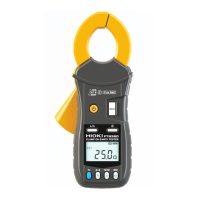2.4 Measurement Procedure
• Do not measure the same location with two or more
Clamp On Earth Testers at the same time. The instru-
ments will interfere with each other, preventing accu-
rate measurement.
• Verify that the mark is not lit up.
When the current flowing through the grounding wire is high
(approximately 2.5 A or greater with a commercial frequency
of 50/60 Hz, approximately 100 mA or greater with a har-
monic component of 1 kHz), the current will affect measured
values, making it impossible to measure the resistance.
Check the current flowing through the grounding wire.
*The current level at which the mark lit up depends on
individual differences as well as the frequency. The closer to
the injected signal frequency, the smaller the noise current
that will affect operation.
• Open display
The screen will show [OPEn] if the clamp is not com-
pletely closed. Close the clamp completely and repeat
the measurement.
*If an extremely large current is flowing through the grounding
wire or a DC current is superposed, the screen may display
[OPEn] even if the clamp is completely closed. This does not
signal a malfunction. Check the current flowing through the
grounding wire by using the instrument's current measure-
ment mode or an instrument such as a clamp tester capable
of DC current measurement.
• Inductor mark
If the [ ] mark next to the resistance mark light up
during measurement, there may be a short in the
ground wire. It is recommended to verify that there are
no shorts in the location being measured.
• Capacitance mark
If the
[
]
mark next to the resistance mark light up
during measurement, there may be a break in the
ground wire. It is recommended to verify that there are
no wiring breaks in the location being measured.
R
x
Short Break
R
x
R
1
R
x
R
1
R
x
[]
[
]
www.GlobalTestSupply.com
Find Quality Products Online at: sales@GlobalTestSupply.com

